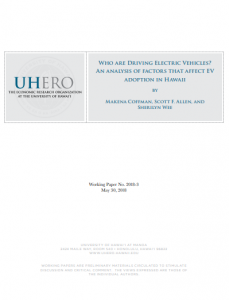Full Title: Who are Driving Electric Vehicles? An analysis of factors that affect EV adoption in Hawaii
Author(s): Makena Coffman, Scott F. Allen, and Sherilyn Wee
Publisher(s): The Economic Research Organization at the University of Hawaii
Publication Date: May 1, 2018
Full Text: Download Resource
Description (excerpt):
Electric vehicles (EVs) have the potential to reduce local air pollution as well as greenhouse gas
emissions, assuming they are predominantly powered with renewable energy. Upon their
reintroduction to the mass vehicle market in 2010, President Obama set a goal of having a million
on the road in the U.S. by 2015. Similarly, in Hawaii, the Hawaii Clean Energy Initiative target was
to have 10,000 EVs on the road by 2015 and 40,000 by 2020. Despite policy support, actual rates of
EV adoption have fallen substantially short of stated goals. By the end of 2017, there were about
770,00 EVs within the U.S., with 6,700 of these in Hawaii. This study uses data on EV registrations
by zipcode in Hawaii to analyze a variety of demographic and transportation factors that might
affect EV adoption. We find that, after controlling for population and gasoline prices, higher income
zipcodes are associated with higher levels of EV adoption – where an increase of $10,000 in median
income is associated with an additional 6 EVs within the 2010-2016 study time period (where the
average zipcode in our sample had 68 EVs in 2016). When educational attainment is measured, we
find that a 1% increase in the number of people with at least a bachelor’s degree increases zipcode
EV adoption by about 76. We find some evidence that gender can matter, similar to other studies
that find that men are more likely to adopt EVs. The effect of age seems to be more robust, where
we find that for every 1-year increase from the average zipcode’s median age, there are 1 to 2 more
EVs. Most notably, we find that commute time affects EV adoption in Hawaii – which is somewhat
surprising given the relatively limited travel distances of an island geography. We find that a 1%
increase in the prevalence of commute times greater than forty-five minutes within a zipcode, likely
meaning they are farther from the central business district, is associated with 37 fewer EVs relative
to those with a commute time under forty-five minutes. This finding holds even when looking at the
island of Oahu alone, which has the majority of the state’s population as well as the majority of EVs.
The island is about forty-four miles long, far less distance than the range offered by most EVs. This
suggests that there may be strong risk-aversion associated with EV range anxiety as well as prompts
further study of the effect of trip-chaining on EV purchase decisions.
